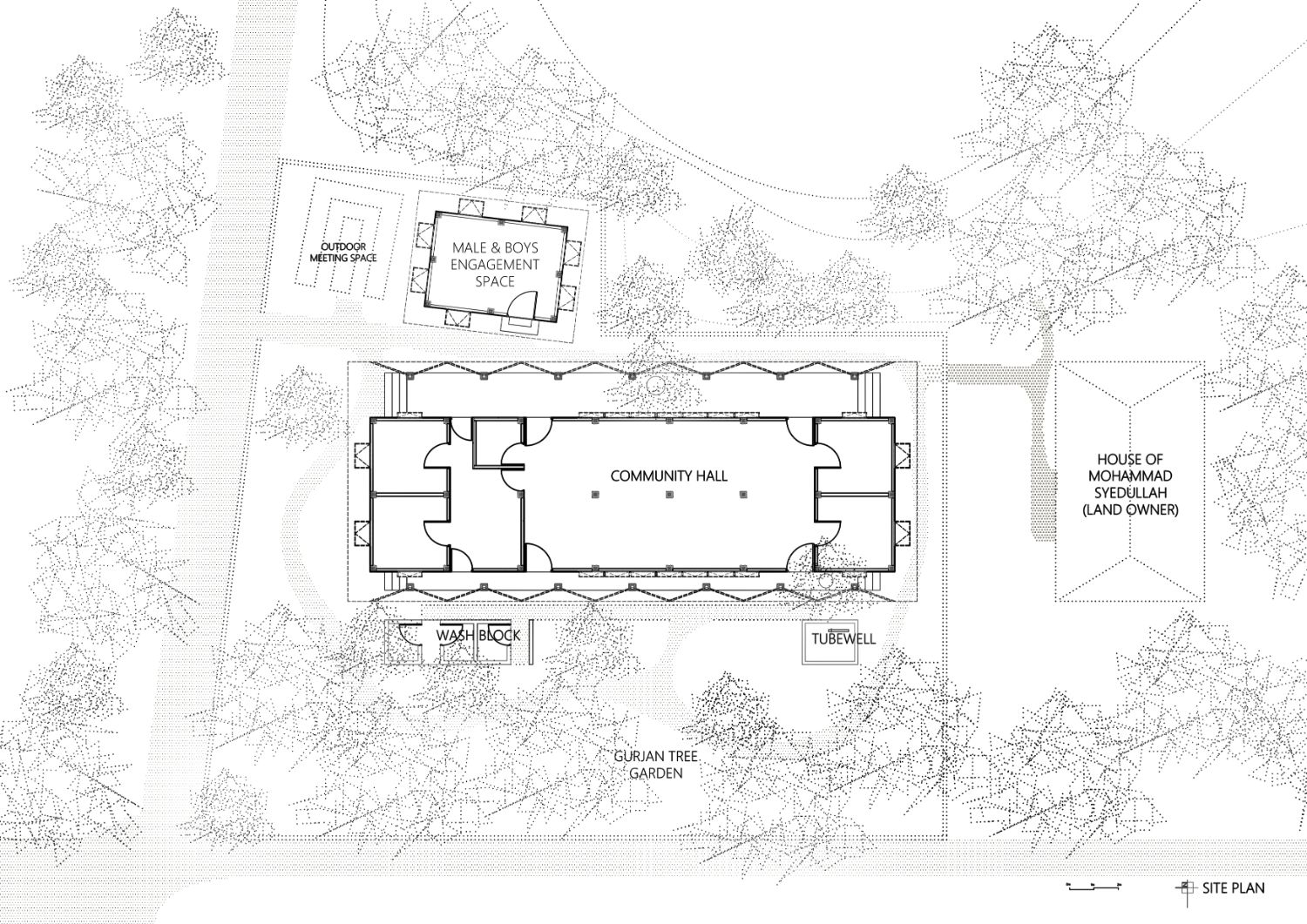Hindupara Integrated Community Center/
Rizvi Hassan
Project Details

Location(City/Country):
Rohingya Refugee Camp, Kutupalong, Cox’s Bazar, Dhaka / Bangladesh
Tipology:
Cultural
Year (Design/Construction):
- / 2019
Area (Net/Gross):
- / 221 m2
Operational Carbon emissions (B6) kgCO2e/m2/y:
-
Embodied Carbon emissions (A1-A3) kgCO2e/m2:
-- The refugee camp has been formed with intensive use of local resources. Rapid use of non-treated bamboo, tarpaulin and straw has made the camp grow like an organic entity in the emergency period.
- Steel structure is easily available as the steel industry in Bangladesh is based in the nearby port city Chittagong. A deployable scheme with steel members as primary structure and flat-pack modules has been designed to ensure less wastage of resources, transportability, reusability and clean construction/ease of construction.
Project description as provided by the Architects:
Hindupara community is the minority group among Rohingya refugees who are now living in the world’s largest refugee camp in Kutupalong. Host communities in Bangladesh have been sharing their resources, land & everyday life for more than two years now. As the host communities are very nearby, Hindupara Integrated Community Center was designed to build a sharing platform that will try to create aspiration for the surrounding, and be a catalyst for better communication between refugees and host community as well as majority and minority groups.
Community members of Hindupara and members from adjacent hosting community have got the scope to come forward to create the center together from which they can be benefitted in terms of psychosocial support, trainings, case management and knowledge sharing. They created patterns and painted their center and created the scope to open up or may be to be a bit more tolerable to each other. Engaging craftsmen & users in the creative process during construction and after automatically makes everyone put a little more effort towards creating and conserving in their own way.
After construction, Rajpoti Shil apa (member of Hindu-para community) and her team selected all the necessary trees and plants that can be planted within the complex as well as can be used in different ceremonies and needs. Gada, Joba, Golap, Kathal Chapa, Barota, Morichha etc. were selected to use the flowers in Puja and other ceremonies. For other purposes like leaf, medicinal benefit and fruits Bel, Kola, Tulshi, Aam etc. came to proposal by the users. Sharing stories and landscaping together immediately helped everyone get introduced to the newly built environment.
The largest refugee camp has been formed in a very short time with immense amount of work and intensive use of local resources. Rapid use of non-treated bamboo, tarpaulin and straw has made the camp grow like an organic entity in the emergency period.
‘The total national supply of bamboo is diminishing over time, whilst demand is growing’-Humanitarian Bamboo Technical Report.
Structural bamboos require almost 3 years re-growing & other partitioning bamboos (i.e Muli/Nali/Ora/Khag/Dolu etc.) require 1year. Unless proper planning is established for harvesting and safely treating Borak bamboo in nearby areas (for lower cost and easy availability in intervals) alternative schemes can play vital roles in the development phase of the camp.
Hence steel comes as an immediate alternative solution which is easily available as the steel industry in Bangladesh is based in the nearby port city Chittagong. A deployable scheme with steel members as primary structure and flat-pack modules has been designed to ensure less wastage of resources, transportability, reusability and clean construction/ease of construction. The scheme consists of a basic base, steel skeleton, modular partitioning as the skin and simple double pitched roof that works as an umbrella in this sub-tropical monsoon climate. Muli bamboo in-fill in the modular system offers contextual essence and makes the structure relatable to Rohingya Refugees as well as local villagers.
In this transitional period, structures in Hindupara Integrated Community Center require to be better in terms of dignity and usability within temporary schemes. For that, deployable/reusable systems that are contextual and adaptable can set examples. It also makes foreign aid a thoughtful investment, instead of mere charity in a humanitarian context.
Project Team: Shah Alam, Rizvi Hassan, Saad Ben Mostafa, Biplob Hossain, Hasan Tarek, Mostafizur Rahman, Sagor Mondol, Abdul Latif, Shahidul Islam Khan, Tahrima Akhtar, Sheikh Jahidur Rahman, Kamal bhai, Rubel bhai ,Rajpoti Shil apa, Md. Syedullah & others.
Clients: Forcefully displaced Myanmar Nationals & Bangladeshi Host Community in Kutupalong (Supported by UNHCR & BRAC)
Collaborators: UNHCR, BRAC
Photo credits: Rizvi Hassan









